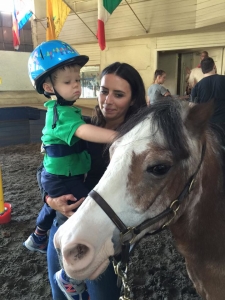Click the picture for the full November 2016 newsletter!
Developmental, Individual Difference, Relationship-Based Model of Intervention (DIR) utilizes affect-based interactions and experiences tailored to individual needs to promote development (Developmental) defines the fundamental capacities for joint attention and regulation, engagement across a wide range of emotions, two-way communication, and complex social problem-solving. These in turn govern the development of symbol formation, language, and intelligence. The I (Individual Differences) refers to individual differences related to sensory reactivity and regulation, visual-spatial auditory/language processing, and purposeful movement. The R (Relationship) refers to relationships with caregivers that are the vehicle for affect-based developmentally appropriate interactions. Parents and families are central to this model because of their ongoing opportunities to support their child’s everyday functioning to carry out emotionally meaningful goals based on developmental levels. Cultural and environmental influences are also considered. The goal of the DIR model is to enable all children, including children on the autism spectrum, to form a sense of themselves as intentional, interactive, related individuals, who can develop cognitive, language, social, and emotional abilities built upon foundational capacities (Stanley Greenspan, Serena Weider). This approach and hippotherapy are similar in that they both utilize the natural environment where less is more. In terms of communication, language, and speech, no materials are needed as it’s all in the relationship and sharing attention with your communication partner.
As part of this model, parents and therapists follow basic principles geared to supporting the mastery of the 6+ functional developmental levels. The foundational capacities include regulation and shared attention, engagement and relating, purposeful emotional interaction/two-way purposeful communication, shared problem solving/sense of self, symbolic thinking/creating ideas, and building bridges/emotional thinking. When interacting and relating with your child in the home, some principles to look for include, however are not limited to, gleam in the eye, using AFFECT, appropriate pacing, and reading the child’s cues. Using the hippotherapy technique, children benefit from the movement of the horse in order to attain a regulated state. Once regulated, engaged, and sharing attention, children are able to utilize language to communicate a variety of functions. They use meaningful language to direct the horse to “walk on” and “whoa” for go and stop. This further allows children to work on turn taking skills, following directions, and comprehension.
Our children show us the power of the relationship. Allow the child to be the agent of his own progress no matter how long it takes. Remember to use wait time and pacing and enjoy the process and wait for the product to unfold. Regulation is key to speech and language development. It’s all about being in the moment, having fun, and allowing your child to feel successful at what they can do and developmentally build from there. It is important for parents, caregivers, and clinicians to use language the child is able to comprehend and can attribute meaning to. When children feel autonomous, competent, and related they are demonstrating the ability to relate, think, and learn for themselves.


